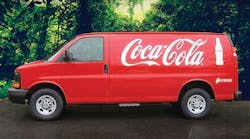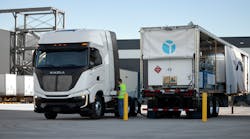Because of their fuel efficiency and low maintenance costs, some of the world’s largest fleets are adopting hybrid electric vehicles (HEV) as part of their sustainability strategies.
Leading the charge in setting the U.S. transportation industry’s first fuel efficiency goal was FedEx Corp. In 2008, it committed to improving its FedEx Express fleet vehicles’ fuel efficiency 20 percent by 2020. In less than five years, FedEx Express exceeded the milestone with a more than 22 percent cumulative improvement in fuel economy.
By 2013, FedEx Corp. saved the equivalent of 86 million gallons of fuel. Being ahead of schedule, it increased its goal to 30 percent improvement in fuel efficiency of its vehicle fleet by 2020.
FedEx Corp. (www.fedex.com) provides a broad portfolio of transportation, e-commerce and business services. Its FedEx Express subsidiary is the world’s largest express transportation company.
EASY CONVERSION
Continuing its focus on innovations, FedEx Express partnered with XL Hybrids, an innovator of hybrid electric powertrain technology, to convert conventional gasoline-powered vans into more fuel-efficient hybrid electric vehicles (HEVs). A driving force in the decision was the technology’s proven efficiencies for fleet vehicles deployed in suburban and urban environments.
The conversion was simple and completed in less than six hours for each vehicle. XL Hybrids added an electric motor, an advanced Li-ion battery pack and sophisticated control software to the FedEx Express vans. There were no significant modifications to the OEM internal combustion engine or transmission.
The OEM powertrain, brakes, fuel and emissions systems operate as normal with a reduced load.
By adding more torque to the output of the transmission with the electric motor, this conversion not only reduces fuel consumption and emissions, but has the potential to extend the engine life. It also extends brake pad and rotor life by a factor of two times or more because the system’s regenerative braking feature does a substantial part of slowing the vehicle, thus reducing the load on the brake system.
COCA-COLA
With the world's largest beverage distribution system, the Coca-Cola Company (www.coca-cola.com), established a goal of reducing its carbon footprint by 25 percent by 2020.
At the end of 2013, Coca-Cola converted 100 newly purchased 2014 Chevrolet Express service vans into fuel-efficient hybrid electric vehicles using XL Hybrids’ powertrain technology.
“Adoption of this hybrid technology supports Coca-Cola’s goal to reduce the carbon footprint embedded in ‘the drink in your hand’ by 25 percent by 2020,” says Bruce Karas, the company’s vice president of environment and sustainability.
“This technology offered an option that provided low maintenance and fuel savings,” Tony Eiermann, manager of asset and value management for Coca-Cola North America, adds. “It was also able to work with our existing fleet.”
Since then, Coca-Cola has seen a 15 to 20 percent fuel consumption reduction compared to its conventional vans. The 100 new hybrid vans are expected to eliminate roughly 4,000 total tons of carbon dioxide emissions that conventional vans would produce in 10 years.
HYBRID ELECTRIC VERSUS ELECTRIC VEHICLES
Compared to major investments required for commercial electric vehicles (EVs) – ranging from $50,000 and $150,000 per vehicle, HEV technology is quick to install with no impact to fleet operations. Other advantages of HEV over EV include:
- HEV components cost less. HEVs have smaller battery packs, about the size of a small carry-on suitcase. An EV requires a large, often heavy battery pack that can be more than 20 kilowatts-per-hour (kWh). An HEV functions well on a battery pack that can be less than 2.0 kWh.
- Fuel savings. HEVs save fleets up to 25 percent on fuel costs, which makes them cost effective right now, regardless of whether there are government incentives in place.
If a fleet van drives 100 miles per day for 250 work days per year in urban and suburban stop-and-go driving, and normally gets 10 mpg with gas at $4 per gallon, an HEV achieving 25 percent fuel savings would yield $2,500 in annual savings.
With an approximate $8,000 premium for an HEV system purchased in volume, the payback on fuel savings alone is just over three years – far better than for an EV. The 10-year lifetime savings is $17,000 on fuel alone.
- HEVs are easier to manage than EVs. Fleets have to avoid risk in order to protect vehicle uptime and ensure route efficiency. There is still a good bit of range anxiety associated with EVs, particularly in areas with extreme seasonal temperatures that can affect battery performance.
EVs also demand the installation of charging infrastructure. HEVs don’t pose these limitations.
Plus, if there is a mechanical failure with an EV, all operations stop until it can be serviced. With an HEV, a driver can continue with his daily operation until it the vehicle can be brought in for service because it will continue running on gasoline.
JUSTIFICATION
Hybrid trucks can reduce brake replacement costs 50 percent or more over the life of the vehicle by extending the interval between replacements. Brake maintenance savings can range from $150 to $750 annually, depending on the size and annual mileage of the vehicle, and should be accounted for in the investment decision.
PAYBACK
Fleets use several different metrics to evaluate an alternative vehicle investment. These include reduced carbon footprint, lifetime net savings, lifetime return on assets and miles or years to break even.
Commercial hybrid powertrains are now available for $8,000 to $10,000 over the base price of conventional models in the commercial light duty segment – pickups, vans, shuttle buses. Plus, the CO2 emissions reduction starts on day-one of operation.
Having breakeven payback in less than five years is critical to sell an initial project internally to management, and a three-year payback is a common fleet buyer threshold to dramatically scale purchases.
For many fleets, the total cost of ownership savings with XL Hybrid vehicles can be more than $15,000 in fuel and maintenance costs, net of purchase price, after subtracting the cost of a hybrid system. The hybrid system pays for itself many times over the life of the vehicle.
A COMPETITIVE EDGE
A small increase to a commercial truck’s fuel economy can provide real value to businesses. Fuel savings can be reinvested on services for the business to differentiate itself from competitors, such as lower prices for customers, enhanced customer service, better product warranty, longer service hours or expanded geographic coverage.
Businesses that do not take action will suffer from lower operating margins.
In fact, businesses that reduce fuel consumption also reduce their company’s exposure to volatile fuel prices and reduce uncertainty about future fuel costs.
While it may seem counterintuitive for managers to think about investing when fuel prices are rising, all companies face the same prices at the pump. Those that adopt efficient vehicles are in a position to invest fuel savings in growing the business.
Jay Sandler is vice president of sales and marketing for XL Hybrids (www.xlhybrids.com). The company designs, manufactures and installs hybrid electric powertrains for commercial vans and trucks. These powertrains can be installed on existing vehicles or as an upfit on new ones.



